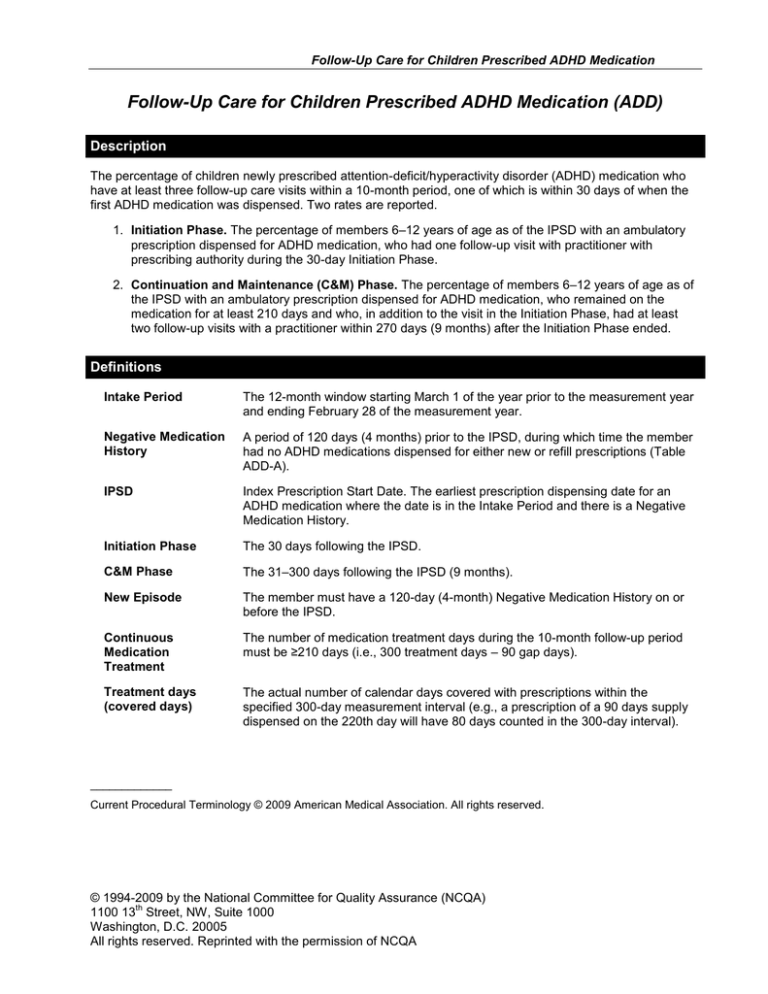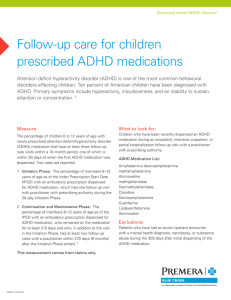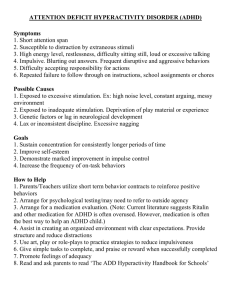
Follow-Up Care for Children Prescribed ADHD Medication
Follow-Up Care for Children Prescribed ADHD Medication (ADD)
Description
The percentage of children newly prescribed attention-deficit/hyperactivity disorder (ADHD) medication who
have at least three follow-up care visits within a 10-month period, one of which is within 30 days of when the
first ADHD medication was dispensed. Two rates are reported.
1. Initiation Phase. The percentage of members 6–12 years of age as of the IPSD with an ambulatory
prescription dispensed for ADHD medication, who had one follow-up visit with practitioner with
prescribing authority during the 30-day Initiation Phase.
2. Continuation and Maintenance (C&M) Phase. The percentage of members 6–12 years of age as of
the IPSD with an ambulatory prescription dispensed for ADHD medication, who remained on the
medication for at least 210 days and who, in addition to the visit in the Initiation Phase, had at least
two follow-up visits with a practitioner within 270 days (9 months) after the Initiation Phase ended.
Definitions
Intake Period
The 12-month window starting March 1 of the year prior to the measurement year
and ending February 28 of the measurement year.
Negative Medication
History
A period of 120 days (4 months) prior to the IPSD, during which time the member
had no ADHD medications dispensed for either new or refill prescriptions (Table
ADD-A).
IPSD
Index Prescription Start Date. The earliest prescription dispensing date for an
ADHD medication where the date is in the Intake Period and there is a Negative
Medication History.
Initiation Phase
The 30 days following the IPSD.
C&M Phase
The 31–300 days following the IPSD (9 months).
New Episode
The member must have a 120-day (4-month) Negative Medication History on or
before the IPSD.
Continuous
Medication
Treatment
The number of medication treatment days during the 10-month follow-up period
must be ≥210 days (i.e., 300 treatment days – 90 gap days).
Treatment days
(covered days)
The actual number of calendar days covered with prescriptions within the
specified 300-day measurement interval (e.g., a prescription of a 90 days supply
dispensed on the 220th day will have 80 days counted in the 300-day interval).
_____________
Current Procedural Terminology © 2009 American Medical Association. All rights reserved.
© 1994-2009 by the National Committee for Quality Assurance (NCQA)
th
1100 13 Street, NW, Suite 1000
Washington, D.C. 20005
All rights reserved. Reprinted with the permission of NCQA
Follow-Up Care for Children Prescribed ADHD Medication
Eligible Population: Rate 1—Initiation Phase
Product lines
Commercial, Medicaid (report each product line separately).
Ages
Six years as of March 1 of the year prior to the measurement year to 12 years as of
February 28 of the measurement year.
Continuous
enrollment
Members must be continuously enrolled in the organization for 120 days (4 months)
prior to the IPSD through 30 days (1 month) after the IPSD.
Allowable gap
None.
Anchor date
None.
Benefits
Medical and pharmacy.
Event
The organization should follow the steps below to identify the eligible population for the
Initiation Phase.
Step 1
Identify all children in the specified age range who were dispensed an ADHD
medication during the 12-month Intake Period (Table ADD-A).
Table ADD-A: ADHD Medications
Description
CNS stimulants
amphetamine-dextroamphetamine
atomoxetine
dexmethylphenidate
Prescription
dextroamphetamine
lisdexamfetamine
methamphetamine
methylphenidate
Note: NCQA will post a comprehensive list of medications and NDC codes to www.ncqa.org by November
16, 2009.
Step 2
Test for Negative Medication History. For each member identified in step 1, test each
ADHD prescription for a Negative Medication History. The IPSD is the dispensing date
of the earliest ADHD prescription in the Intake Period with a Negative Medication
History.
Step 3
Calculate continuous enrollment. Members must be continuously enrolled for 120 days
prior to the IPSD through 30 days after the IPSD.
Step 4
Exclude members who had an acute inpatient claim/encounter with a principal diagnosis
of mental health (Tables MPT-A, MPT-B) or substance abuse (Table ADD-B) during the
30 days after the IPSD.
Table ADD-B: Codes to Identify Substance Abuse
Principal ICD-9-CM Diagnosis
291-292, 303-305
Principal ICD-9-CM Diagnosis
960-979
WITH
Secondary ICD-9-CM Diagnosis
291-292, 303-304, 305.0, 305.2-305.9, 535.3, 571.1
© 1994-2009 by the National Committee for Quality Assurance (NCQA)
th
1100 13 Street, NW, Suite 1000
Washington, D.C. 20005
All rights reserved. Reprinted with the permission of NCQA
Follow-Up Care for Children Prescribed ADHD Medication
Administrative Specification: Rate 1—Initiation Phase
Denominator
The Rate 1 eligible population.
Numerator
One outpatient, intensive outpatient or partial hospitalization follow-up visit with a
practitioner with prescribing authority within 30 days after the IPSD. Use Table ADD-C
to identify the follow-up visit. This must be a face-to-face visit with a practitioner.
Note: Do not count a visit on the IPSD as the Initiation Phase visit.
Table ADD-C: Codes to Identify Follow-Up Visits
CPT
HCPCS
90804-90815, 96150-96154, 98960-98962, 99078,
G0155, G0176, G0177, H0002, H0004,
99201-99205, 99211-99215, 99217-99220, 99241- H0031, H0034-H0037, H0039, H0040,
99245, 99341-99345, 99347-99350, 99383, 99384, H2000, H2001, H2010-H2020, M0064,
99393, 99394, 99401-99404, 99411, 99412, 99510 S0201, S9480, S9484, S9485
CPT
90801, 90802, 90816-90819, 90821-90824, 90826-90829, 90845, 90847, 90849, 90853, 90857,
90862, 90875, 90876
UB Revenue
0510, 0513, 0515-0517, 0519-0523,
0526-0529, 077x, 0900, 0902-0905,
0907, 0911-0917, 0919, 0982, 0983
99221-99223, 99231-99233, 99238, 99239, 99251-99255
WITH
WITH
POS
03, 05, 07, 09, 11, 12, 13,
14, 15, 20, 22, 33, 49, 50,
52, 53, 71, 72
52, 53
Eligible Population: Rate 2—C&M Phase
Product lines
Commercial, Medicaid (report each product line separately).
Ages
Six years as of March 1 of the year prior to the measurement year to 12 years as of
February 28 of the measurement year.
Continuous
enrollment
Members must be continuously enrolled in the organization for 120 days (4 months)
prior to the IPSD and 300 days (10 months) after the IPSD.
Members who switch product lines between the Rate 1 and Rate 2 continuous
enrollment periods should only be included in Rate 1.
Allowable gap
One 45-day gap in enrollment between 31 days and 300 days after the IPSD. To
determine continuous enrollment for a Medicaid beneficiary for whom enrollment is
verified monthly, the member may not have more than a 1-month gap in coverage (i.e.,
a member whose coverage lapses for 2 months [60 days] is not considered
continuously enrolled).
Anchor date
None.
Benefits
Medical and pharmacy.
Event
The organization should follow the steps below to identify the eligible population for the
C&M Phase.
_____________
Current Procedural Terminology © 2009 American Medical Association. All rights reserved.
© 1994-2009 by the National Committee for Quality Assurance (NCQA)
th
1100 13 Street, NW, Suite 1000
Washington, D.C. 20005
All rights reserved. Reprinted with the permission of NCQA
Follow-Up Care for Children Prescribed ADHD Medication
Step 1
Identify all members who meet the eligible population criteria for Rate 1—Initiation Phase.
Step 2
Calculate continuous enrollment. Members must be continuously enrolled from 31 days
(1 month) through 300 days (10 months) after the IPSD.
Step 3
Calculate the continuous medication treatment. Using the members in step 2, determine if the
member filled a sufficient number of prescriptions to provide continuous treatment for at least
210 days out of the 300-day period. The ―continuous medication treatment‖ definition allows
gaps in medication treatment, up to a total of 90 days during the 300-day (10-month) period.
(This period spans the Initiation Phase [1 month] and the C&M Phase [9 months].)
Allowable medication changes or gaps include the following.
Washout period gaps to change medication
Treatment gaps to refill the same medication
―Drug holidays‖ from stimulant medication
Regardless of the number of gaps, the total gap days may be no more than 90. The
organization may count any combination of gaps (e.g., one washout gap of 14 days and
numerous weekend drug holidays).
Step 4
Exclude members who had an acute inpatient claim/encounter with a principal diagnosis of
mental health (Tables MPT-A, MPT-B) or substance abuse (Table ADD-B) during the 300 days
after the IPSD.
Administrative Specification: Rate 2—C&M Phase
Denominator
The Rate 2 eligible population.
Numerator
Identify all members who meet the following criteria.
An Initiation Phase Visit in the first 30 days, and
At least two follow-up visits from 31–300 days after the IPSD
One of the two visits (during days 31–300) may be a telephone visit with practitioner.
Refer to Table ADD-C for codes to identify follow-up visits; refer to Table ADD-D for
codes to identify telephone visits.
Table ADD-D: Codes to Identify Telephone Visits
CPT
98966-98968, 99371-99373, 99441-99443
_____________
Current Procedural Terminology © 2009 American Medical Association. All rights reserved.
© 1994-2009 by the National Committee for Quality Assurance (NCQA)
th
1100 13 Street, NW, Suite 1000
Washington, D.C. 20005
All rights reserved. Reprinted with the permission of NCQA
Follow-Up Care for Children Prescribed ADHD Medication
Exclusions (optional)
Members diagnosed with narcolepsy at any point in their medical history (Table ADD-E).
Table ADD-E: Code to Identify Exclusions
Description
Narcolepsy
ICD-9-CM Diagnosis
347
Note
Members who have multiple overlapping prescriptions should count the overlap days once
toward the days supply. Identify different drugs using the Drug ID field located in the NDC list
at www.ncqa.org.
Refer to Appendix 3 for the definition of mental health practitioner and prescribing practitioner.
Organizations may have different methods for billing intensive outpatient encounters and
partial hospitalizations. Some methods may be comparable to outpatient billing, with separate
claims for each date of service; others may be comparable to inpatient billing, with an
admission date, a discharge date and units of service. Organizations whose billing methods
are comparable to inpatient billing may count each unit of service as an individual visit. The unit
of service must have occurred during the time frame required for the rate (e.g., within 30 days
after or from 31–300 days after the IPSD).
Data Elements for Reporting
Organizations that submit HEDIS data to NCQA must provide the following data elements.
Table ADD-1/2: Data Elements for Follow-Up Care for Children
Prescribed ADHD Medication
Administrative
Measurement year
Data collection methodology (Administrative)
Eligible population
Each of the 2 rates
Numerator events by administrative data
Each of the 2 rates
Reported rate
Each of the 2 rates
Lower 95% confidence interval
Each of the 2 rates
Upper 95% confidence interval
Each of the 2 rates
© 1994-2009 by the National Committee for Quality Assurance (NCQA)
th
1100 13 Street, NW, Suite 1000
Washington, D.C. 20005
All rights reserved. Reprinted with the permission of NCQA



